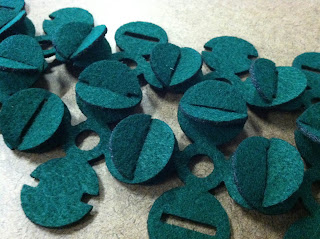For my serial slicing contour assignment I created the tail of a
cetacean dolphin/whale appearing just above the ocean surface. The initial idea of modeling a dolphin spawned from my adolescent memories of visiting my mother every summer when she lived in Panama City Beach, Florida after my parents' divorce. I especially remember a handful of somewhat rare occasions of seeing wild dolphins in the lagoon, creating my own dolphin sand sculptures a couple times when the ocean was full of seaweed, and finally getting to swim with dolphins in Jamaica on a Carnival Cruise excursion after graduating from high school.
I looked up some reference photos of dolphin sculptures, but wasn't quite satisfied with any of them until I came across this photo (below) and was inspired to just create the tail above the surface.
As I modeled the tail, I began to think about more symbolic reasons for modeling only the tail vs. the entire ocean mammal. Besides its simplicity, I recognized the indistinctness of the form. Is it a dolphin tail? Or is it a whale tail? Above I briefly shared my memories from adolescence that relate to dolphins. Below I will share some of my present day experiences that relate to whales...
In my class presentation (before writing this blog post), I likened the tail to the top of an iceberg. We can only see what appears above the surface (when the whale needs to breathe) unless we choose to take the plunge and investigate below the surface. According to
this source,
"the whale symbolizes emotional creativity, well-being, nurturing as well as emotional depth." To be honest, I have been experiencing a lot of emotional turmoil during the past couple weeks. My MFA thesis project was completely attacked by my team in the same week that I found out that I had a contagious skin infection and accidentally transmitted it to my significant other. The stress became paralyzing, induced a constant bout of anxiety for two days, and caused repressed feelings to surface. It was time to face some of the deeper issues so I sought counsel. The form also represents my current internal battle with how much personal information to disclose outside my innermost circle of trusted family and friends.
So let me ask again, "Is it a dolphin tail? Or is it a whale tail?"
In regard to modeling techniques, I modeled the cetacean tail in Autodesk Maya. I used a cylinder for the base. After deleting the top triangular faces, I extruded the curve several times, scaling it accordingly, and manipulated vertices. Once I was satisfied with the shape of 1/4 of the model, I used the mirror tool to create the form. Then I exported the model as an .obj and imported it to Rhino--where I created a contoured version and prepared it for laser cutting.
For the Keyshot material, I used the light-blue, transparent gemstone material as opposed to a non-transparent colored material. In the coming months, I desire to become more transparent about creating art for therapeutic reasons. All in all, this project was quite liberating. I'm looking forward to expanding upon this theme and creating both meaningful and challenging works of art.



















































